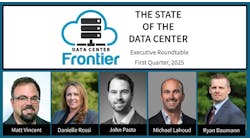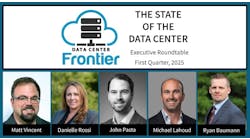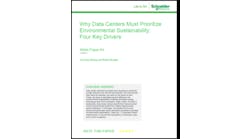The Data Center Frontier Executive Roundtable features insights from industry executives with lengthy experience in the data center industry.
Here’s a look at the Q1 2025 insights from John Pasta, Executive Vice President - Data Center Solutions, JLL.
John Pasta is a member of JLL’s Data Center Solutions Advisory team. He focuses on all facets of data center user representation, investment sales, and development projects. John has over a decade experience in the commercial real estate industry and six years experience working directly for one of the largest data center developers globally. He holds a Bachelor of Arts in Biology and a minor in business from The University of Texas and is a licensed salesperson in the state of Texas.
Power Infrastructure & Energy Resilience in 2025
Data Center Frontier: As power constraints intensify across key data center markets, how are industry leaders addressing energy security, backup power solutions, and the integration of alternative energy sources such as hydrogen, natural gas, and nuclear?
John Pasta, JLL: Industry leaders are tackling escalating power constraints with a multi-faceted approach to ensure both reliability and sustainability. To safeguard operations against grid instability, they are investing heavily in robust backup systems, such as microgrids and high-capacity generators, which can seamlessly take over during outages. Beyond traditional backups, there’s a noticeable interest in alternative energy sources to meet growing immediate demand. These include natural gas, which offers a stable and relatively cleaner transitional fuel, hydrogen fuel cells, which promise zero-emission power generation, and small modular nuclear reactors (SMRs), an emerging technology offering compact, scalable, and long-term energy solutions.
Simultaneously, renewable energy sources like wind and solar are being integrated into power portfolios wherever practical. However, their intermittent nature—solar only generates during the day, and wind depends on weather—necessitates advanced energy storage solutions, such as large-scale lithium-ion batteries to store excess power for use during peak demand. For instance, in Texas, utilities like Oncor and grid operator ERCOT are grappling with unprecedented demand surges driven by data centers supporting AI and cloud computing. Here, operators are collaborating with local stakeholders to balance load growth with grid stability, ensuring that power infrastructure keeps pace with the industry’s unrelenting demand.
The Cooling Imperative: Managing High-Density AI Workloads
Data Center Frontier: With the rapid rise of AI-driven workloads pushing power densities beyond traditional limits, what new cooling technologies and efficiency strategies are being deployed to maintain operational stability and sustainability?
John Pasta, JLL: The rise of high-density AI workloads is pushing data center cooling systems to their limits. Traditional air-based cooling is insufficient beyond 40-50kW, prompting a widespread adoption of liquid cooling technologies. Solutions like direct-to-chip cooling, where coolant is delivered directly to the processors, and rear door heat exchangers, which use liquid to remove heat at the rack level, are becoming standard.
Liquid cooling also offers significant energy efficiency benefits. Compared to air cooling, it requires less power to achieve the same temperature control, reducing overall electricity consumption. This aligns with sustainability goals by lowering the carbon footprint of cooling operations and enabling innovative practices like heat reuse—where captured heat is repurposed for nearby heating needs, such as office spaces or district heating systems.
Site Selection & Market Evolution in a Constrained Environment
Data Center Frontier: Given ongoing challenges in land acquisition, power availability, and local regulatory hurdles, how are data center operators refining their site selection strategies in Q1 2025? Which North American markets are emerging as the next hotspots for development?
John Pasta, JLL: In 2025, site selection strategies are all about access to power on the shortest time frame. Favorable regulations, tax incentives, and streamlined permitting processes also play a critical role.
While established hubs like Northern Virginia and Dallas continue to thrive, emerging markets are gaining momentum. Indiana, Louisiana, and Mississippi for example, are becoming a hotspot thanks to its affordable land, access to power, and state-backed incentives, attracting major investments from hyperscalers like Meta, Microsoft, AWS, and Google. Previously "pioneering" locations such as West Texas are also drawing major attention from these groups as well.
The Changing Economics of Data Center Development
Data Center Frontier: With rising construction costs, supply chain challenges, and shifting enterprise demands, how are data center providers, energy specialists, and real estate firms adapting their business models to sustain growth and profitability in 2025?
John Pasta, JLL: Operators face rising construction costs, supply chain disruptions, and shifting customer expectations, particularly from enterprises embracing AI and hybrid cloud models. To stay competitive, providers are leaning into efficient technologies that optimize both cost and environmental impact. Liquid cooling, as noted earlier, reduces energy expenses and emissions compared to traditional methods. Similarly, modular construction—using prefabricated components assembled on-site—cuts build times, lowers labor costs, and allows for scalable expansion as demand fluctuates.
Geographic strategy is another lever for profitability. Operators are expanding into cost-effective markets like Texas and Indiana, where affordable power (often from a mix of gas and renewables) and lower land prices reduce upfront investment. In Texas, partnerships with utilities like Oncor and grid operator ERCOT enable operators to secure power agreements that support massive data center campuses. Ultimately, the persistent imbalance in the supply-demand dynamic continues to favor operators, enabling them to incrementally raise rental rates. This trend ensures the financial viability of new projects, allowing them to meet investment thresholds and proceed with development.

Matt Vincent
A B2B technology journalist and editor with more than two decades of experience, Matt Vincent is Editor in Chief of Data Center Frontier.






